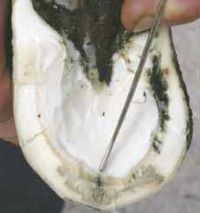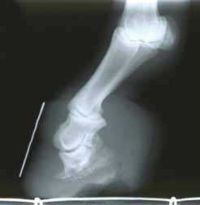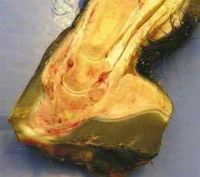Foot Disease (Chronic) - Donkey
Introduction

Chronic foot disease includes:
- White line disease
- Seedy toe
- Onychomycosis
- Hollow hoof disease
- Chronic laminitis
- Chronic founder
It is often difficult to separate these conditions. From experience, it would be suggested that in many ways they are interlinked, varying only in the degree to which the individual exhibits symptoms. Occasionally, minor seedy toe lesions may be seen in otherwise normal hoof, however, significant lesions will almost invariably be associated with other abnormalities and the recommended approach to the care of these problems is similar.
White line disease and seedy toe are usually conditions of significance following recurrent laminar disease. Poorer quality horn and the 'stretched' white line, especially at the toe, allows entry of fungi and bacteria that further degrade the hoof capsule.
Diagnosis
Seedy toe initially affects the horn layers adjacent to the white line and may radiate from a point of penetration of the white line. The horn is grey and crumbly with lesions varying from minor pockets in the hoof wall to extensive separation of the wall from the white line. The severe lesions can extend for several centimeters towards the coronary band and for much of the circumference of the hoof. These lesions may sound hollow on percussion as they are filled with degenerate mix of crumbling hoof material and debris.
- Predisposing factors:
- Damp or dirty bedding
- Muddy paddocks
- Faecal or urinary contamination
- Poor diet
- Recurrent/chronic laminar disease
- Delayed farriery
- Old age
Clinical Signs
Seedy toe lesions are rarely acutely painful, but they may predispose to abscessation, which causes lameness.

Chronic laminar disease
- Obvious depression of the soft tissue at the midline coronary band
- The sole is often flat or convex and may be thin and soft
- The hoof wall has growth rings which are crimped together at the toe, yet diverge towards the heel
- The white line is often stretched, especially at the toe
- Strong digital pulses may be felt
- The gate in advanced cases may be 'pottering', with shoulders pushed forwards
- Recurrent solar abscesses
- Flexor tendon thickening
- A history of obesity, excess grazing and infrequent farriery
Laboratory Tests
Radiography
Chronic laminar disease
- Weigh-bearing lateral views with markers are very useful for treatment and prognosis
- Lipping of the dorsal border of the distal phalanx is an early sign. More pronounced lipping/remodelling, deterioration in bone density and rotation are more useful guides to chronicity and prognosis than founder distance.
Treatment

Seedy toe All of the above predisposing factors need to be addressed.
- The initial treatment is aimed at removing all of the diseased tissue back to clean, healthy horn. Care must be taken to avoid damaging the sensitive tissues of the dermal lamellae and corium. The sole needs to remain thicker as weight will inevitably be borne by it. It has to be able to withstand thumb pressure. A thick pad on the contra-lateral foot may aid trimming of the second limb.
- Topical non-toxic anti-fungal agents may be applied. Sugardine is a useful preparation - see treatment of pedal sepsis. Synthetic hoof fillers are contra-indicated as they may trap potentially harmful organisms.
- A deep, clean, well-managed bed (wood shavings are particularly useful) should be considered until the wall has grown down and the donkey is comfortable on other surfaces.
- A balanced diet and appropriate supplementation should be considered. Fat animals should be dieted but not starved.
- The feet should be regularly inspected and any new lesions removed. Routine trimming should be planned for every 6-10 weeks.
- Also include:
- Advice on diet, management, body weight and grazing
- Consideration of Cushing's disease
- Glue-on plastic shoes which may help reduce solar trauma
- Avoiding overzealous or inappropriate foot trimming
- Provision of long term analgesia
- Euthanasia should be considered in deteriorating or severely affected animals
Prognosis
The prognosis for the successful long-term treatment of capsular problems would seem to be significantly worse in cases with advanced, chronic laminar disease.
Literature Search
Use these links to find recent scientific publications via CAB Abstracts (log in required unless accessing from a subscribing organisation).
Chronic foot disease in donkeys publications
References
- Crane, M. (2008) The donkey's foot In Svendsen, E.D., Duncan, J. and Hadrill, D. (2008) The Professional Handbook of the Donkey, 4th edition, Whittet Books, Chapter 10
|
|
This section was sponsored and content provided by THE DONKEY SANCTUARY |
|---|
